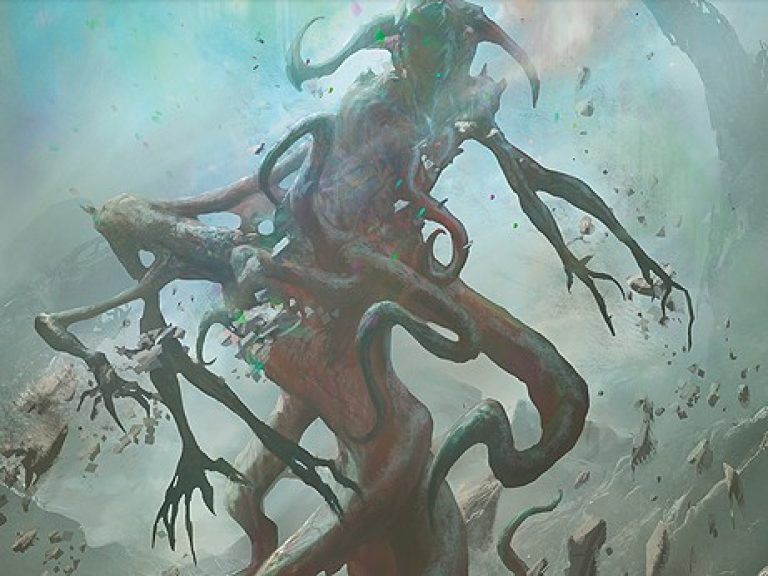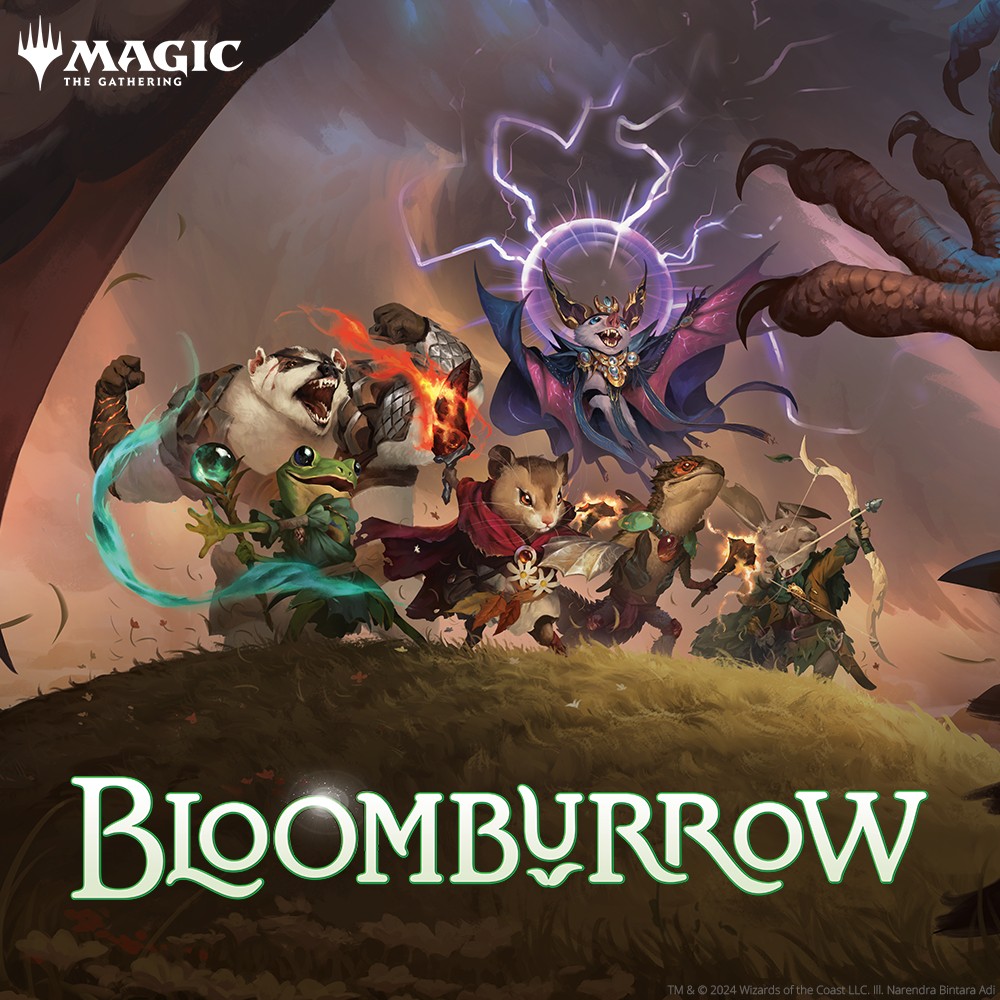Those following Magic Online Leagues (or noting deck finishes at the Cincinnati Open) are aware of the new powerhouse in town: Eldrazi. It has been 5-0ing leagues in different colour combinations and it’s caught a lot of attention. I’m going to take this article to explain the deck, its strengths and weaknesses.
Deck Summary
The deck has a fairly straight-forward game plan:
- Hold off the opponent in the early game
- Exile your opponent’s graveyard while you ramp your mana base
- Play big Eldrazi
Most people will compare the deck to Tron and that’s somewhat accurate. You’re playing large threats earlier than you normally should. However, in terms of play style, most will agree that the Eldrazi is more interactive and "fairer".
Deck Skeleton
The deck’s skeleton is small, centered on black, but otherwise mostly colorless. This is why we’ve been able to see so many successful colour combinations. You can seemingly run any colours you want... as long as it includes black.
Mana Base
These are the lands we’re holding off the opponent in the early game for. There are many reasons the deck is black first and foremost, one of the most important is Urborg, Tomb of Yawgmoth. One of the most fun interactions is when it’s combined with Eye of Ugin. With only these two legendary lands, you can take care of four CMC from your favourite Eldrazi. Add an Eldrazi Temple in the mix and you can put out some intimidating threats fairly quickly.
The second best interaction is when it’s combined with Oblivion Sower. If you’re lucky enough to put several of your opponent’s lands into play, their irrelevant fetchlands (or other lands) become relevant as they would now tap for black.
Side note: If you follow Magic’s financial aspects, you’ll have noticed the significant price spikes that hit Eldrazi Temple and Eye of Ugin recently. This deck is the reason.
Creature Base
At a glance, it looks like a Standard deck because its creature base is entirely from Battle for Zendikar. The creature base is consistent between variants:
It follows an easy-to-follow curve: You (hopefully) two-for-one your opponents early game with Wasteland Strangler. Hold back your mid-range opponents (while ramping) with Blight Herder and Oblivion Sower. Finally, finish them off with an Ulamog, the Ceaseless Hunger.
Without Tarmogoyfs to compete with (see Utility below), they become some of the biggest creatures on Modern battlefields.
Utility
As the deck becomes stronger when there are opponent's cards in exile, it needs to put them there with Relic of Progenitus, Scrabbling Claws or Nihil Spellbomb. Decks run nothing less than four Relics and a combination of the others. In a pinch, they cycle so you can dig for answers. Lists will sometimes include Expedition Map to tutor up powerful lands like the ones mentioned above, or one-of utility lands such as Bojuka Bog, Cavern of Souls or Vault of the Archangel.
As mentioned earlier, it is very important to hold off faster decks or more unfair decks until you get your fatties out. The deck does that with removal and a hefty hand-hate package of Thoughtseizes and Inquisition of Kozileks. With that, you'll typically see abundant removal in the form of Slaughter Pact, Go for the Throat. Additionally (or alternatively), you would see different removal depending on the deck's second colour (ex. Lightning Bolt, Path to Exile).
Strengths & Weaknesses
The decks closest comparable is RG Tron. Similar to RG Tron:
- It goes "over" fair decks (ie.: its creatures are bigger and better).
- It has a tough time with decks that go "under" it (ie.: are faster).
- Some main board cards take care of some otherwise unfavorable match-ups (ex.: Relic of Progenitus).
- There are few "silver bullets" that shut down the deck.
If the decks are so similar, why not run Tron? Especially since it's favored against Eldrazi? Many reasons:
- Its main board is more versatile because of its hand-hate.
- It's resilient to counter-magic (because of on-cast abilities).
- It's stronger against decks that use their graveyards (this includes Tarmogoyfs).
Enough of how good it is, where are its weaknesses? It's three major weaknesses are:
- Awful initial draws: Given the number of colorless lands you run, and the high mana cost of creatures, you can see some pretty nasty seven card draws.
- Abysmal aggro match-up: This needs to be said. The aggro match-up is rough. Black is not conducive to easy life gain or stalling early and it shows.
- Low card advantage: Unlike decks like focusing on two-for-ones, Eldrazi has a difficulty grinding card advantage.
Playing Against The Deck
Like Jund and Tron, there aren't really any silver bullets but there are little things along the way that can help your match-up.
- Blood Moon, Crumble to Dust, Ghost Quarter and friends will buy you time.
- Artifact destruction isn't all that effective since the deck's artifacts can be cycled if targeted.
- A resolved Ensnaring Bridge would slow the deck considerably.
- As big and frightening Ulamog is, he still disappears to Path to Exile. (He is indestructible.)
- Stony Silence shuts off its artifacts. However, it is not super effective, especially if there are a few cards already in exile.
- Avoid putting cards in your graveyard unless you really need to. (This includes fetchlands)
- When targeted with Relic of Progenitus or Scrabbling Claws, you'll be tempted to put lands into exile. Keep in mind this feeds Oblivion Sower.
Tips & Tricks for the Eldrazi Player
- Spells that are suspended can be processed. Usual suspects: Living End, Rift Bolt, Search for Tomorrow and cards you have Delayed.
- You can cycle Scrabbling Claws targeting a card in your graveyard if your opponent has no targets.
- You can win against infinite life with Ulamog.
- Keep an eye on your opponent's card count in their deck. You will win some of your cards through milling your opponent and its important to know how many times Ulamog needs to attack.
- Don't be afraid to cycle your artifacts early. Though it helps, the deck does not need to process cards and could function well with two to three exiled cards.
- You can get lands destroyed with Ghost Quarter with Oblivion Sower (provided you've exiled them). This includes man-lands or opponent Ghost Quarters.
Sample Decklists
Several colour combinations have put up good numbers recently. Each have their strengths and weaknesses, so I'd suggest looking at your play-style and meta to find out which is right for you:
- Mono-black
Cheapest to build and the most consistent. Little damage from fetches/shocks, but also the least versatile sideboard. - Rakdos
Has the versatility of Lightning Bolt with the added benefit of strong sideboard cards: Pyroclasm, Crumble to Dust and Slaughter Games. - Dimir
Though not specifically in this decklist, there are people experimenting with Delay and Ashiok, Nightmare Weaver. - Grixis
Very risky mana-base, but the payoff comes with the card quality. - Orzhov
Lingering Souls gives you bodies to block Infect and Affinity. Path to Exile feeds the exile pile for processing. Provides its own set of strong sideboard cards: ex.: Timely Reinforcements, Stony Silence
Personally, I've been toying with Rakdos and Orzhov and I feel overall Orzhov is the strongest. The addition of white improves enough match-ups to be worth the reduced efficiency of a two-color mana base. Rakdos is similar, but for the purposes of this deck, Lingering Souls and Path to Exile are more conducive to the deck's plan than Lightning Bolts.
- Mono-black is fairly streamlined, but not versatile enough.
- Dimir's tricks are cute, but they simply aren't strong or consistent enough.
- Going two colours is probably the furthest you can stretch this manabase. A third is much too rocky.
Summary
The new Eldrazi deck has its strengths but it's definitely not the be-all-and-end-all of Modern Magic. Some have suggested that it will push other fair mid-range decks out of the format. Even in the current meta, an archetype's most prominent deck doesn't muscle out similar decks. This is because the match-ups will usually be different between decks. In the unusual case a deck does everything another deck does, but better (including its matchups), only then will it push the other deck out, but that simply isn't the case with Eldrazi.
Also, with Oath of the Gatewatch around the corner adding Eldrazi playables to the card pool, I don't think this will be the last we see the deck.


